Great Barracuda
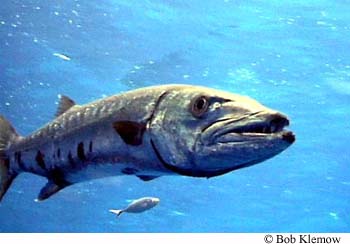
Sphyraena barracuda
This long, tubular fish has a very pointed snout filled with two rows of teeth, and small fins set back towards its crescent caudal (tail) fin. It is a shiny blue-gray above, fading to silver and white below, usually with dark spots on its lower sides, and sometimes with faint darker bars on its upper side. This is a successful daytime ambush hunter that can burst in speeds up to 35 mph, and is a danger to humans because it will mistakenly attack shiny objects or fish caught on spears. It can grow to over 5 feet long and over 100 pounds.
Order – Perciformes
Family – Sphyraenidae
Genus – Sphyraena
Species – barracuda
Common Names
Great barracuda, barracuda, barra, Commerson’s sea pike, and short barracuda are common English language names. Other names include alu (Carolinian), amerikanischer pfeilhecht (German), barkura (Miskito), barrcouda (French), barracuda bicuda (Portuguese), bicuda (Portuguese), chai (Palauan), gaviana (Portuguese), kadd (Arabic), kaku (Hawaiian), kucul (Malay), kupala (Hawaiian), ono (Tahitian), picua (Spanish), picúa corsaria (German), picuda (Spanish), seraw (Carolinian), snoek (Dutch), tenak (Malay), and zub-saalim (Somali) are common names that refer to this fish.
Importance to Humans
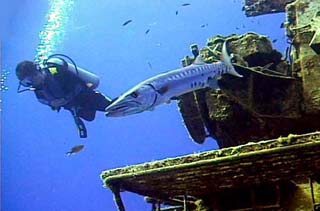
Although not prized as a commercial fish in North American waters, the great barracuda puts up a good fight and is therefore esteemed by some anglers as a gamefish. They may be caught with a variety of gear including handlines, rod and reel, seines, trammel nets, and gill nets. The great barracuda has been implicated in cases of ciguatera poisoning within certain areas of its range. Ciguatera poisoning is caused by the bioaccumulation of ciguatoxins in the flesh of tropical marine fishes. Ciguatoxins are produced by marine dinoflagellates that grow attached to marine algae and as such may be incidentally ingested by herbivorous fishes. Large piscivorous reef dwelling fishes occupying the apex of the food chain become reservoirs for the highest amounts of ciguatoxin by feeding on other members of the reef community. Poisoned people report gastrointestinal maladies that may last several days, a general weakness in their arms and legs, and a reversal in the ability to differentiate hot versus cold. The illness is serious and symptoms may persist for weeks.
Danger to Humans
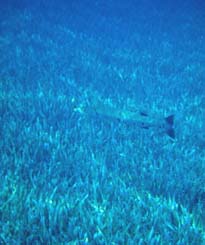
Attacks on humans by great barracuda are rare. Inquisitive, sight-oriented fish, barracudas sometimes exhibit the unnerving habit of trailing snorkelers and divers. When attacks occur more often than not it is because a barracuda attempts to steal a fish from spearfishers or mistakenly interprets a shiny object, such as a diving knife, for the glint of a shiny fish. Such incidents usually consist of one very quick strike, the result of which may be a laceration and some loss of tissue. Fatalities from barracuda attacks are rare. In 1947, a death off Key West was attributed to a barracuda, followed by another case off the coast of North Carolina in 1957. A well-documented barracuda attack occurred on a free diver off Pompano Beach, Florida in 1960. The diver was bitten twice, and the resulting injuries required 31 stitches. However, such attacks are uncommon and more often than not easily preventable with a few simple precautions.
Conservation
The barracuda is not listed as endangered or vulnerable with the World Conservation Union (IUCN). The IUCN is a global union of states, governmental agencies, and non-governmental organizations in a partnership that assesses the conservation status of species.
> Check the status of the great barracuda at the IUCN website.
Geographical Distribution
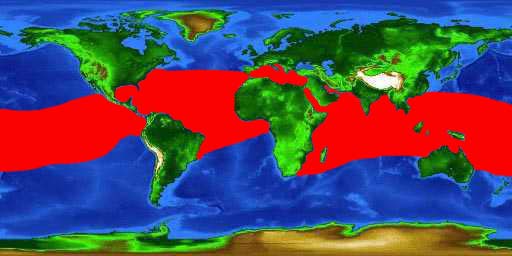
Occurring worldwide in near shore tropical and subtropical seas (30°N – 30°S), the great barracuda is common in the western Atlantic Ocean from Massachusetts (U.S.) to Brazil. It is also found in the Gulf of Mexico and the Caribbean Sea as well as the eastern Atlantic Ocean, Indo-Pacific, and the Red Sea. It is rare or absent in areas of the eastern Pacific Ocean.
Habitat
Great barracuda commonly occur in nearshore coral reefs, seagrasses, and mangroves. They may also reside in the open ocean, living predominantly at or near the surface, although they are at times found at depths to 325 feet (100m). Barracudas tend to be solitary but are sometimes found in small aggregations over reefs and sandy bottoms. Juveniles mature amongst mangroves and seagrass beds, habitats that offer cover from predators. During the second year of life, barracuda move to deeper reef habitats. Juveniles and some adults have been observed in areas that receive high amounts of freshwater input, however adults generally tend to avoid areas of brackish water.
Biology
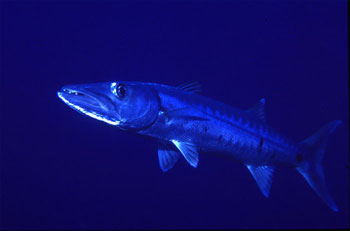
Distinctive Features
The great barracuda has a slender, streamlined body that is round in the mid-section. The top of the head between the eyes is nearly flat and the mouth is large, containing many large sharp teeth and a projecting lower jaw. The pectoral fin tips extend to the origin of the pelvic fins. The spinous and soft dorsal fins are widely separated and the double emarginate tail fin exhibits pale tips on each lobe.
Coloration
Body coloration of the great barracuda is brownish or bluish gray on the dorsum and upper side, with a greenish cast shading to silvery on the sides and a white belly. The upper side may have 18-23 dark bars most often observable when the fish is resting or over a variegated substrate. The black spots on the lower sides of the great barracuda distinguish it from other species of barracuda. The second dorsal fin, anal, and caudal fins are violet to black with whitish tips. Young barracuda exhibit pale reticulations on the dorsum and a dark stripe on either side that breaks into spots as the fish grows. These patterns are somewhat ephemeral though as juveniles can alter their color patterns to closely match that of their surroundings. These changes in coloration serve to camouflage the fish from predators as well as well as wary prey. Adults have similar coloration along with a more silvery appearance that is advantageous to a fish that swims near the surface of the water.
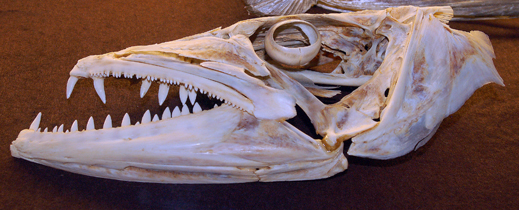
Dentition
The great barracuda has a large mouth containing two sets of razor-sharp teeth, making it an efficient predator. There is a row of small razor-sharp teeth along the outside of the jaw with a larger set of dagger-like teeth within these. The closely set teeth are flattened and triangular with sharp edges used to tear the flesh of prey. Long needlelike teeth fit into their own holes in the opposing jaw, allowing the great barracuda to close its mouth. This gives its prey little chance of escape. This fish grabs its prey, swallowing small victims whole while larger prey is cut into pieces to be swallowed separately.
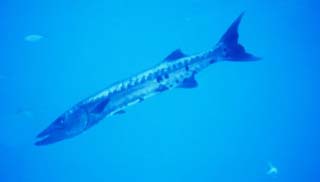
Size, Age, and Growth
Great barracuda are large fish. The record for a hook and line caught great barracuda is 1.7 meters (5.5 feet), 44 kg (103 lbs) and the species is reported to attain a size of 2 meters, 50 kg. Any barracuda over 4.8 feet (1.5 m) in length can be considered very large. Based on scale analysis of large specimens, great barracuda have a lifespan of at least 14 years. Sexual maturity is reached at a length of about 23 inches (60 cm). At this size, males are typically about two years and females close to four years of age.
Food Habits
Great barracudas feed on an array of prey including fishes such as jacks, grunts, groupers, snappers, small tunas, mullets, killifishes, herrings, and anchovies. Barracudas have a large gape and very sharp teeth, enabling them to feed on large fishes by chopping them in half. An opportunistic predator, great barracuda feed throughout the water column. Generally a diurnal fish, great barracuda locate their prey largely by sight. The body plan of the great barracuda is designed for speed and it is estimated that top speed for the species may be as fast as 36 mph (58 kph).
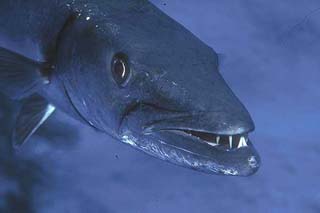
Reproduction
The timing and location of spawning has not been well documented. It is believed that spawning takes place in deeper, offshore waters. Evidence exists that barracuda are seasonal spawners and in the Florida Keys they are believed to breed in the spring. During the spawning event, eggs are released and fertilized in open waters and dispersed by the currents. Newly hatched larvae bear little resemblance to adults. Seeking safety from predators as well as a source of food, the larvae settle in shallow, vegetated areas of estuaries. Juveniles become recognizable as miniature versions of the adults at about .5 inches (1.3 cm) in length. At a length of about 1.2 inches (3cm), the juveniles move to open waters within the estuary, eventually leaving the estuary altogether at a size of about 5 cm (2 inches) in length. These juvenile barracuda spend the remainder of their first year of life within mangrove and seagrass habitats. During the second year of life, they move to deep reef areas where they will spend their adulthood.
Predators
There are few predators that are large enough and fast enough to feed on adult great barracuda. Sharks, tuna, and goliath grouper have been known to feed on small adult barracuda. Juveniles likely fall prey to a variety of inshore predators.
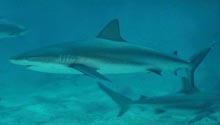
Parasites
In general, the barracuda has few parasites for a fish that has been well studied. The monogean trematodePseudochauhanea sphyraenae is an ectoparasite occurring on the gills of the great barracuda. Copepods have also been observed around the mouth area of this fish. Other parasites include protozoans, numerous digenea (flukes), monogenea (gillworms), cestoda (tapeworms), nematoda (round worms), isopods, and fish lice. The great barracuda is also parasitized by other fish (ectoparasites) including the live sharksuckerEcheneis naucrates, pilotfish Naucrates ductor, slender suckerfish Phtheirichthys lineatus, spearfish remoraRemora brachyptera, and marlin sucker Remora osteochir.
Taxonomy
Johann Julius Walbaum first described Sphyraena barracuda in 1792. The genus Sphyraena is Latin meaning a pike-like fish. Synonyms include S. picuda Bloch and Schneider 1801, S. picuda picuda Bloch and Schneider 1801, S. becuna Cuvier 1829, S. commersonii Cuvier 1829, and S. dussumieri Valenciennes 1831.
Prepared by: Cathleen Bester